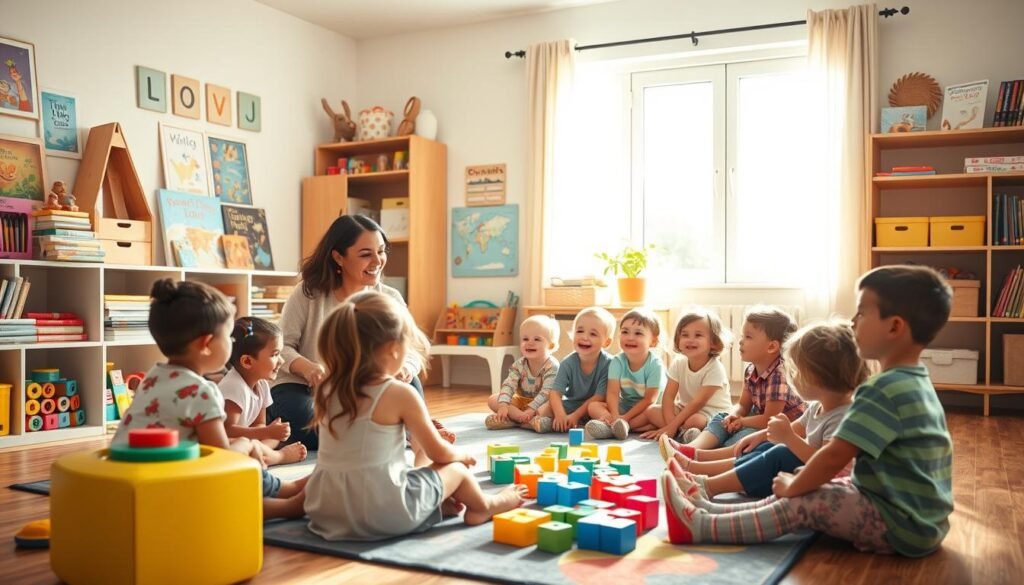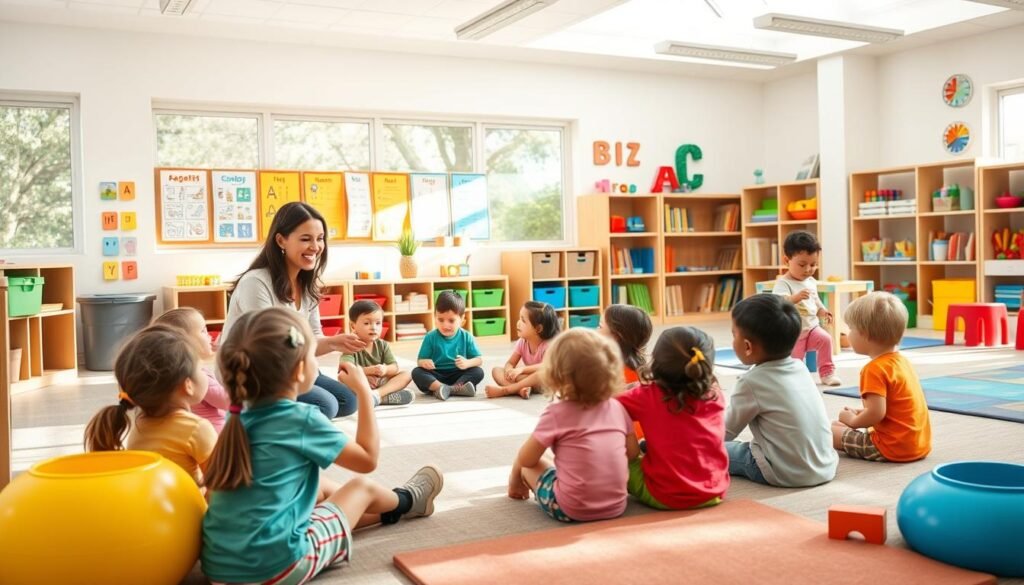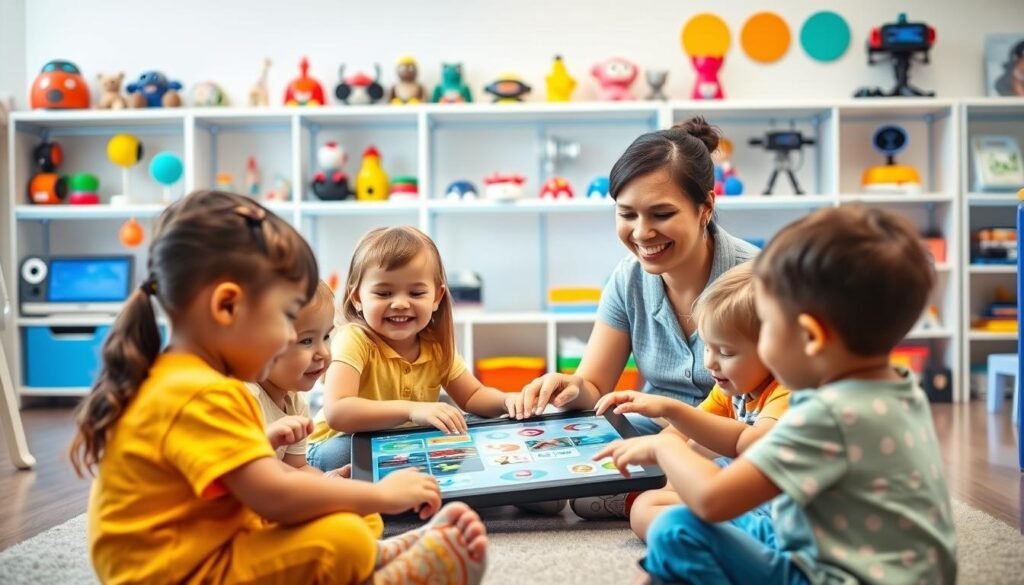
Best Lesson Plans for Preschool help teachers create engaging and effective learning experiences. Creating a good lesson plan is key for early learning.
Creating a good lesson plan for preschool is key for early learning. Teachers are crucial in making learning fun and helping kids grow. They use 52+ free theme planning pages to make learning fun and structured.
A great lesson plan does more than just activities. It gives kids a sense of security and teaches important skills. These plans include reading, math, play, and learning about feelings and social skills.
Planning lessons for preschool needs careful thought. Short, fun activities keep kids interested. Hands-on activities like art and games help kids learn by doing. The aim is to help kids grow in many ways.
Table of Contents
Best Lesson Plans for Preschool: Understanding Structured Learning
Early childhood is a key time for building basic skills that affect your child’s future learning. Preschool curriculum is vital in helping young minds grow during this important period.
It’s important to know about developmental milestones to make learning effective. Young kids need structured yet flexible learning that encourages their curiosity and brain growth.
“Play is the highest form of research.” – Albert Einstein
Benefits of Early Childhood Education
Quality early education brings many benefits for kids:
- Enhanced social skill development
- Improved cognitive abilities
- Better school readiness
- Increased emotional intelligence
Impact on Cognitive Development
A good preschool curriculum boosts brain development with fun learning activities. Studies show it greatly improves kids’ math and language skills.
Role of Play-Based Learning
Play is a powerful way to teach kids naturally. Interactive games, art projects, and group activities let them explore and learn about the world. They meet important developmental goals this way.
Teachers can make learning fun and engaging with activities that match kids’ ages. This sparks their interest and love for learning.
Essential Components of the Best Lesson Plans for Preschool
Creating lesson plans for preschoolers needs careful thought. It’s about using the right teaching strategies and learning goals. Understanding how young children learn is key to a great preschool curriculum.
Lesson planning has three main steps for engaging learning:
- Motivational opening to capture children’s attention
- Structured lesson development
- Meaningful lesson closure
Your teaching methods should keep kids interested. Hands-on activities are very important. Think about ways for kids to:
- Make posters
- Build dioramas
- Create charts and graphs
- Develop small group projects
When setting learning goals, use different ways to practice. This could be through talking, doing things with objects, or working together. Regular checks help find any gaps in learning and make sure kids are growing as they should.
The key to successful preschool lesson planning is flexibility and creativity in approaching educational goals.
Always end lessons on a high note to keep kids’ spirits up. This keeps them excited for more learning. By using these strategies, you’ll make a learning space that supports and grows young minds.
Theme-Based Learning Approaches
Preschool education is all about fun and learning. It uses creative classroom activities to grab young minds. Themes help make learning both enjoyable and meaningful. They tie together different subjects in a fun way.
Hands-on learning is key in theme-based units. Studies show it boosts understanding and thinking skills in kids. With many themes and topics, teachers can craft engaging lessons.
Popular Preschool Themes
Exciting themes turn learning into fun adventures. Some top themes include:
- Animals and Habitats
- Seasons and Weather
- Community Helpers
- Transportation
- Five Senses
- Feelings and Emotions
Seasonal and Holiday Themes
Seasonal themes link learning to everyday life. Teachers can create fun activities for:
- Back to School
- Winter Wonderland
- Spring Growth
- Summer Exploration
- Harvest and Autumn
Cultural and Diversity Themes
Preschool is a great time to learn about different cultures. All About Me and family themes teach kids about being unique. Exploring cultural celebrations helps kids understand and empathize with others.
Theme-based learning captures children’s interest and makes education an exciting journey of discovery.
Developing Age-Appropriate Activities
Creating fun and fitting lessons for preschoolers needs careful thought. It’s important to know what stage of development they are at. Teaching resources help make activities that are just right for young minds.
When planning activities for preschoolers, teachers must think about a few things:
- How fast each child is growing
- What they can learn
- How ready they are to share and feel emotions
- What they can do physically
Experts say activities should match up with certain milestones in early childhood. For example, activities that help with fine motor skills might include:
- Threading beads
- Using child-safe scissors
- Playing with play dough
- Drawing simple shapes
“Every child is unique, and age-appropriate lessons should reflect their individual learning potential.”
Being creative keeps kids interested. Using different senses in activities makes learning fun for all. Hands-on exploration is a key part of teaching in preschool.
By planning lessons that fit each child’s needs, teachers help them feel safe to explore and learn.
Incorporating Multi-Sensory Learning Experiences
Preschool education is all about engaging kids through different senses. Multi-sensory learning makes learning fun and interactive. It helps young learners soak up information better.
Studies show that hands-on learning boosts memory. It uses different brain paths to help kids remember more. Teachers can make learning exciting by using various senses.
Visual Learning Activities
Seeing is a big part of learning in early years. Good teaching methods include:
- Colorful picture books
- Interactive learning charts
- Animated educational videos
- Color-coded learning materials
Auditory Learning Methods
Learning through sound helps with language and listening. Techniques like:
- Rhythmic songs and rhymes
- Storytelling with varied vocal expressions
- Musical instrument exploration
- Sound matching games
Tactile Learning Opportunities
Touching and feeling helps kids learn. Activities like:
- Sensory bins with different textures
- Clay modeling
- Sand and water play
- Finger painting
Multi-sensory learning isn’t just an educational approach—it’s a gateway to deeper understanding and engagement for young learners.
Lesson Plan for Preschool: Step-by-Step Implementation Guide

Creating a good lesson plan for preschool needs careful planning and smart thinking. Your activities should be fun, right for their age, and help them grow.
Here are the key steps to make your lesson plan:
- Set Clear Learning Objectives
- Know what skills to focus on
- Make sure they match what kids should learn at their age
- Gather Necessary Materials
- Get the right learning tools for their age
- Make sure everything is safe for kids
- Design Engaging Activities
- Make learning fun with different senses
- Use activities that get kids involved
Your lesson plan should have flexible transitions between activities. This keeps kids interested and helps avoid bad behavior. Use pictures or songs to tell kids when it’s time to move on.
Successful preschool learning happens when activities are both structured and playful.
It’s important to check how kids are doing. Use watching to see how they’re growing and change your plan if needed. Every child learns at their own pace, so pay attention to each one.
Assessment and Progress Monitoring Strategies
Tracking developmental milestones is key in early childhood education. It’s more than just tests. It’s about knowing each child’s learning journey. How your preschool tracks progress can really shape a child’s learning.
Good early childhood education needs detailed observation and keeping records. With strong monitoring tools, teachers can see how kids grow and learn.
Observation Techniques
Observation is the heart of understanding developmental milestones. Here are some effective ways:
- Anecdotal record keeping
- Structured classroom observations
- Periodic skill assessment checklists
- Video documentation of learning interactions
Documentation Methods
Keeping track of a child’s progress needs careful documentation. Here are some good methods:
- Digital learning portfolios
- Developmental milestone trackers
- Narrative learning stories
- Individual progress journals
Parent Communication Tools
Keeping parents in the loop is important. Use modern tools like:
- Monthly progress reports
- Digital communication platforms
- Scheduled parent-teacher conferences
- Interactive learning update apps
Progress monitoring isn’t about ranking children, but understanding their unique learning paths.
Integrating Technology in Preschool Learning

Technology is now a key part of preschool teaching. It can make learning fun and engaging for young kids.
The American Academy of Pediatrics suggests kids aged 2 to 5 should use digital media for only one hour a day. Teachers should pick educational apps and tools that fit the learning goals.
- Interactive educational apps like TeachMe cover foundational topics
- Moose Math helps children learn counting and basic mathematics
- Digital tools support skill development in literacy and problem-solving
Teachers can use technology to make learning better. Collaborative digital activities help kids think critically in a fun way.
90% of educators agree that technology should complement, not replace, traditional learning approaches.
When adding technology, consider these points:
- Selecting age-appropriate educational apps
- Balancing screen time with hands-on activities
- Using interactive tools that promote learning
- Ensuring meaningful engagement
By using smart teaching resources, teachers can make learning exciting. This prepares kids for a digital world while keeping learning right for their age.
Creating Inclusive Learning Environments
Creating an inclusive preschool curriculum needs careful planning. It’s about supporting every child’s unique learning path. Your classroom activities should show the diversity of children’s backgrounds and abilities.
By using Universal Design for Learning (UDL) principles, you make a welcoming space for all. This approach ensures that every student’s needs are met.
Accessibility is more than just physical space. When planning your curriculum, think about visual aids, different ways to communicate, and materials that adapt to various needs. Group activities and games help build empathy and social bonds, making every child feel valued.
Family involvement is vital in creating inclusive classrooms. Keeping in touch with parents builds strong partnerships that support each child’s growth. Educators need to keep learning too. Workshops and training help you understand and apply inclusive education practices, creating a space where all children can succeed.
Your aim is to make classroom activities that celebrate diversity and understanding. Using culturally responsive teaching and relevant materials helps children grow in compassion. It prepares them to be open-minded and appreciate differences.
